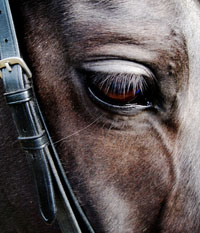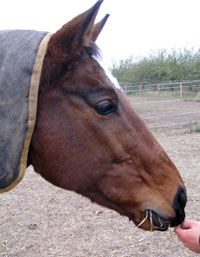Image: Wikipedia Commons
The adult botfly is about 13mm long (1/2 inch) and looks similar to a bee but it cannot suck, bite or feed because it's mouth parts are degenerate. They will hover close to horses on warm days, making a humming sound as they fly, and lay their eggs on the horse. Up to 300 eggs an hour.
It takes the eggs 9-10 days to hatch but the larvae have to be licked into the horse's mouth before they can start to develop. Some types wander around the tongue, others burrow into the cheeks or gullet of the horse for about 20 -30 days they then live in the horse's stomach for up to 10 months living off the horse's food. The maggots can cause inflammation and disrupt the digestion. Some botfly maggots have been known to reach the brain of their host.
When they are ready to pupate the maggots drop from the stomach wall and pass out through the rectum. On the ground they wriggle into a crevice and pupate. After another 3 weeks the adult fly will hatch and be ready to lay it's eggs on a horse.
Botfly eggs are tiny tan coloured specks, they can be removed before the horse ingests them using a specially purchased bot knife as shown below.
Image: Horse and Man
This procedure should be done somewhere where horses do not eat or there will be the danger of an equine ingesting the removed eggs.
A regular worming program will help to break the botflies lifecycle by destroying larvae and maggots.
There are three species of botfly that target the horse and each species lays their eggs in a different place on the horse:
Gastrophilus intestinalis the common horse bot lays it's eggs on the legs, sides and flanks.
Gastrophilus nasalis the throat bot lays it 's eggs under the head, neck and mane.
Gatrrophilus haemorrhoidalis lays it's eggs on the muzzle.
To receive our monthly horse care tips in your in box simply send us a quick email using Newsletter as the subject. We will only ever send you our newsletters, we won't spam you and we won't share your email with anyone else and you can unsubscribe at any time. Want to see what you'll get, in February we wrote about rodent control Rodent Control around the stableyard / barn - newsletter




